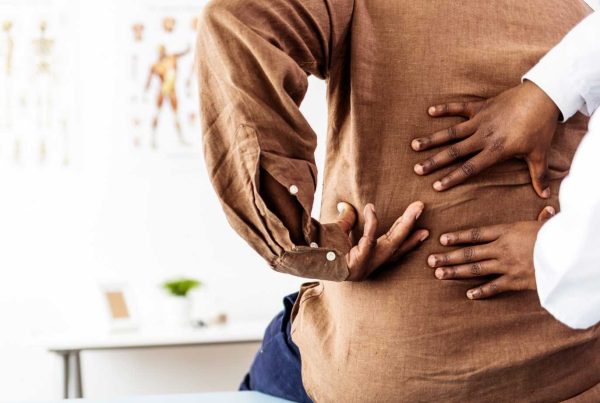You don’t have to bend over backward to take care of your back.
For more information or to schedule an appointment with a MetroHealth spine specialist, call 216-778-3700.
Hear from spine patients Michael and Sharon, who found relief by visiting our spine experts.
The warm weather gives people an opportunity to get outside and get moving, whether it’s cleaning the garage, digging in the garden or running around with their kids at the park. While it’s important to keep your body in motion, “you should know your limitations and take some precautions to help prevent lower back injury,” said Chong H. Kim, MD, a pain medicine specialist at MetroHealth’s Spine Center.
Here are some tips for keeping your back healthy:
Stand up straight.
Maintaining proper alignment of your spine can help prevent back injury. Need a reminder of what good posture feels like? Stand with your back against a wall, with your heels, rear end and shoulder blades touching it.
Don’t lift with your back.
Whether you’re moving heavy boxes, picking up your little one or removing yard debris, keep your back straight when lifting. Lift by bending at the knees and hips rather than at the back and shoulders. This reduces strain on your back muscles.
Take breaks.
Be sure to rest and hydrate during your spring activities. When you’re tired, you’re more likely to have poor posture. Or, you may grab a box that’s too heavy without thinking. Break up your tasks. You don’t need to plant an entire spring garden in one day.
Use proper equipment.
If you’re gardening, wear heavy-soled shoes with good traction to reduce stress on your joints, including those in your back. Cleaning the garage? Use a dolly to move cumbersome or weighty items rather than lifting or dragging them.
Don’t rely on back braces.
Back braces have not been proven to prevent back injury. They can also give you a false sense of security when lifting heavy items.
Try a new physical activity that strengthens your back.
Swimming can strengthen your back and core muscles and is easy on your joints, all of which can promote back health. Yoga can help increase your flexibility, increase core strength and improve balance, which are all beneficial for your back.
Know when it’s time to see a doctor.
Most of the time, back pain resolves on its own. However, it’s important to be aware of the severity of your back issues and how long they persist. If you find issues with your back are worsening or lasting more than a few weeks, it may be time to call a doctor.
When Might Surgery Be Necessary?
Some back pain can resolve on its own or be treated with medication or a nerve block, which involves injecting an anesthetic close to the nerve that is causing the pain (see patient story). When these approaches don’t work, “you may want to meet with a surgeon to discuss further options,” said Jonathan E. Belding, MD, an orthopedic surgeon with MetroHealth’s Spine Center.
Surgery can help relieve pain caused by sciatica, herniated discs and compression of the lower spinal cord (lumbar spinal stenosis) that has not responded to other treatments. It can also correct painful spinal malalignment or curvature.
“We use a lot of new surgical techniques that require small incisions or result in very little muscle damage,” said Dr. Belding. “The result is many surgeries can be done on an outpatient basis and have a shorter healing time.”
While touted as a minimally invasive approach, Dr. Belding does not recommend laser surgery to patients with back pain, because the research does not support its use.
Dr. Belding and his colleagues at the Spine Center are always happy to talk to people about how to address their pain. “Dr. Kim and I work well together, because we think that each person’s pain should be dealt with on an individual basis.”
For more information or to schedule an appointment with a MetroHealth spine specialist, call 216-778-3700.
Hear from two patients who found relief by visiting our spine experts
Michael Dragutinovic’s experience at the MetroHealth Spine Center changed his life for the better. “I went in for surgery in a wheelchair, and now, if I had to run down the hall, I could do it with no problem,” he said. Read more about Michael’s life-changing experience.
A nonsurgical approach was the best option for Sharon Radon. “It worked. No more pain radiating down my thigh. It’s like a miracle,” she said. Learn more about Sharon.













